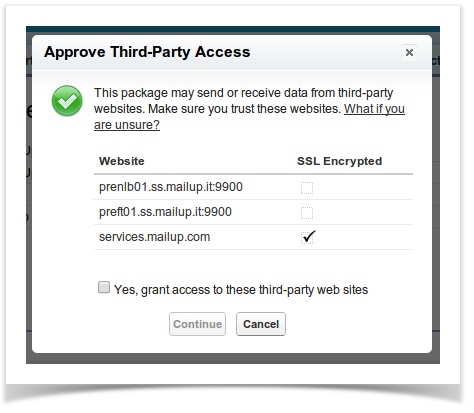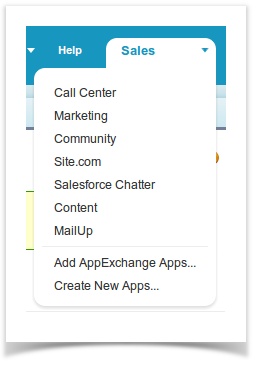Next: please authorize the communication between your MailUp account and Salesforce by selecting the appropriate checkbox and clicking on Continue.
You will then see a summary of the API access requirements for this package. Just click on Next to proceed.
You can then define the access levels for your different users' roles: select the desired granted level and click on Continue.
You have now completed your configuration and can click on Install.
Once the installation has been completed, you will find the MailUp for Salesforce connector listed together with other installed components in the Sales menu.
Editing your Salesforce layouts
The next steps is to edit a few of the layouts used in Salesforce for use with the connector.
Campaign Layout
First you will need to edit the Campaign page layout.
- Access the Campaign PageLayout: at the left column of your Salesforce console by selecting Build > Customize > Campaigns > Page layout.
- First add a custom MailUp button to the page:
- Click Edit and select the MailUp button (already available in your fields and buttons lists).
- Drag it to the custom buttons area in the Campaign Detail section
- Save the layout changes by clicking on the Save button at the upper left corner.
- Next, you will add some new fields to the Campaign page layout
- To do so click again on Edit, and select Fields.
- Click on the Section button and drag it to the area you want the MailUp section to appear (normally below Campaign Details section)
- A pop-up will appear to configure the section:
- Name the section MailUp
- Select the 2-column option (the tab-key order option doesn't matter)
- Click OK
- Now that you have added a MailUp section to the page, add the following fields to it by dragging and dropping the corresponding buttons into that section
- MailUp total views
- MailUp total clicks
- MailUp total bounces
- MailUp total unsubscription
- The new MailUp section should look similar to this:
- Click on Save to save the changes to the Campaign layout.
Campaign Member Layout
Follow the same process to edit your Campaign Member Page Layout.
You will find it under Build > Customize > Campaigns > Campaign Member > Page Layout.
- Create a MailUp section by dragging the Section button into the Campaign Details section
- Name it MailUp and save the edited layout.
- Add the following fields to it by dragging and dropping the corresponding buttons into that section
- Views
- Clicks
- Bounced
- Unsubscribed
- The new MailUp section should look similar to this:
- Click on Save to save the changes to the Campaign Member layout.
Connecting Salesforce to your MailUp account
It's now time to connect your Salesforce organization to a List in your MailUp account.
- Use the new Configuration tab to configure the MailUp for Salesforce connector
- Add the following data to the form that will be displayed:
- ConsoleID: this is your MailUp account ID, which is the numeric portion of your main user name. Let's say your user name is m12345: your MailUp console ID is 12345
- MailUp Username: the user name associated with your master user. It starts with the letter "m" (e.g: m12345)
- MailUp Password: the password associated with your master user
- MailUp List ID: the ID of the List in your MailUp account that you wish to connect to. It's an integer and you can find it in your MailUp admin console next to the list name.
- End point URL: the MailUp console URL (e.g.: http://b0x5a.s42.net). If you are unsure of what this URL looks like for your MailUp account:
- Log into your MailUp admin console
- Look at the URL in the browser address field
- Copy the first portion of the URL, which should look like similar to this: http://b0x5a.s42.net
- Note that we have removed everything after the domain (E.g. remove "/console/etc...")
- First click on Activate Console. Once you receive a success message, click on Save to save your settings.
Warning
MailUp is a multi-list environment, but you can only associate with your Salesforce organization one MailUp account and one LIst within that account.
Any contacts or message that will be exported from Salesforce into your MailUp console will be available within that List.
Scheduling tasks
Your Salesforce organization is now connected to the list your specified in your MailUp account. The bottom of the Configuration page has another section called Schedule Task.
This section is meant to allow you to schedule an import of your email campaign statistics. The statistics will be retrieved once a day at the time you specify for a period of a month after you sent your campaign.
Mapping fields
Finally, you will want to map fields between your lead and contact database in Salesforce and your recipient database in MailUp (learn more about custom recipient fields in MailUp).
To do so, click on the new Field Mapping tab in the navigation.
- On the left you will see the recipient fields imported from MailUp
- In the second and third column you will see Lead and Contact Fields
- Map the ones that are relevant to you: when campaign members are pushed to MailUp during the setup of a MailUp campaign in Salesforce, the data contained in the fields mapped on this page will be copied from Salesforce to MailUp.
- You do not need to map all the fields
- When you are done, click on Save at the top of the page.
Warning
Your're done!
You've completed the installation and configuration of the MailUp connector for Salesforce.
You can now start your first campaign!










